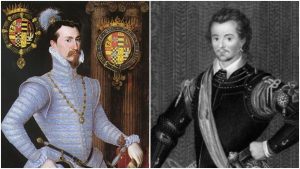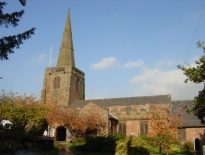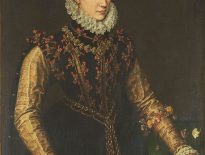
Douglas's lover, Robert Dudley, and their son, Robert.
Douglas Sheffield, née Howard, was the oldest daughter of William Howard, 1st Baron Howard of Effingham, Surrey, and his wife, Margaret Gamage. Her date of birth has been a source of debate among historians. However, Simon Adams has argued that the dates of 1542 and 1543 are the most likely due to her being seventeen upon her marriage in 1560. Her older brother was Charles Howard, 2nd Baron of Effingham and 1st Earl of Nottingham. Charles was a successful English statesman and Lord High Admiral under Elizabeth I and James I. Commander of the English forces, he was hugely influential during the Armada period and was renowned for having been a significant figure in the naval defence against Spanish invasion during the 1590s. Douglas was part of a distinguished and notorious noble family that had been instrumental in court politics since the early sixteenth century. While her father held the title of baron, his half-brother was the Duke of Norfolk, William enjoyed a successful career under all four of the Tudor monarchs, and this favour ensured his daughter made a good marriage; Douglas married John Sheffield, 2nd Baron Sheffield. The couple had two surviving children: Edmund Sheffield, later 1st Earl of Mulgrave, and a daughter, Elizabeth, who married Thomas Butler, 10th Earl of Ormonde. The newly married couple were received well by the queen, who provided a wedding gift on 27th October 1560.
It was during the early 1570s that Douglas, likely unintentionally, fashioned a reputation for herself as a notorious figure at the Elizabethan court. She began an affair with Robert Dudley, Earl of Leicester. As a successful courtier and magnate, he embodied the fundamental qualities that were considered ideal for a renaissance courtier: brave, virtuous and an upholder of Protestantism, both domestically and abroad. More importantly, Leicester was the renowned favourite of Queen Elizabeth. Rumours began to circulate at court, around 1573, of a potential affair between the two courtiers. Court contemporary, Gilbert Talbot, stated that both Lady Sheffield and her sister, Frances Howard, were at great wars for Leicester’s attention and were ‘very far in love with him’. Similarly, Leicester appears to have been equally infatuated with Lady Sheffield. An undated letter written to her at some point before 1573 suggests this, with Leicester stressing that he could not marry Douglas for fear of Elizabeth’s displeasure. Regardless of their relationship status, Douglas gave birth in 1574 to Leicester’s illegitimate son, named Robert Dudley, in honour of his father.
Alongside their unconventional relationship, Leicester’s enemies monopolised on his affair with court women. A slanderous book that circulated in Elizabethan England, entitled Leicester’s Commonwealth (1584), intended to condemn Leicester and his Protestant sympathies. Traditionally cited as Roman Catholic propaganda, it also intended to embellish his affair with Mistress Sheffield. The book states that their affair began at Belvoir Castle during a royal progress in 1568. Furthermore, it argues that Douglas and Leicester produced another illegitimate child, a daughter, at Dudley Castle. However, there are several issues with the author’s statement. Firstly, Elizabeth never visited Belvoir Castle, and secondly, in 1604, Douglas denied any further illegitimate children with Leicester. Minus the children she had within wedlock, with her two husbands, there is no documented evidence of her producing any other surviving children. Her son, Robert, did however become infamous for his dramatic relationship with his mother. In 1604 he wished to claim his father’s and his uncle’s extinct titles of Earl of Leicester and Earl of Warwick. The case was taken to the Star Chamber and aroused great public interest between 1604-1605. The court heard ninety witnesses for Dudley and fifty-seven for Leicester’s widow, Lettice Knollys. Lady Sheffield was not in attendance at the trial but attempted to prove Dudley’s legitimacy; arguing that she did indeed marry Leicester in a solemn affair in Esher, Surrey in 1573. This purported ceremony was never validated, and from the evidence, it suggests that she was putting forward a completely fictitious story.
Sheffield’s husband had died in 1568, leaving her in a precarious situation in terms of financial security. However, on 28th November 1579 after being widowed for over a decade, she married, in secret, the gentleman pensioner Edward Stafford. Lady Sheffield evidently broke the conventional, virtuous norms associated with Elizabeth’s female courtiers. Her relationship with Leicester was undoubtedly controversial; her secret union with Stafford being no different as she had not received the queen’s blessing to marry. Soon after their marriage, Stafford left for France as the queen’s envoy to the Duke of Anjou. This was likely to discuss the potential marriage negotiations that dominated this period; an Anglo-French match that was vehemently opposed by a number of Elizabethan courtiers and statesmen, including Leicester. To support this, at the Norwich entertainments in 1578, Elizabeth’s virginity was emphasised as an ideal state of being for a female monarch. This was in contrast with earlier revels and pageantry, during the 1560s, that advocated wedlock for the queen. During the Anjou discussions a life of perpetual virginity was deemed more desirable than marriage to a foreigner; especially a Frenchman.
Stafford returned to England in 1580 and received an unwelcome, and volatile, audience with the queen. Similarly, Lady Sheffield was interrogated for her secret marriage with Stafford; contemporaries recording that she responded in ‘hysterics’. It is interesting that Lady Sheffield decided to marry in 1579, barely a year after Leicester had engaged in matrimony with Lettice Knollys, the Dowager Countess of Essex. This scandalous affair resulted in Knolly’s banishment from court (Elizabeth & Lettice’s relationship never became anything more than moderately amicable for the remainder of the queen’s life) and Leicester becoming, temporarily, out of favour with the queen. Ultimately the former was infuriated, and embarrassed, by the unauthorised actions of her courtiers. Stafford and Lady Sheffield produced two sons who unfortunately predeceased both their parents. Marriage brought Douglas little financial security, with the couple living modestly off her jointure. However, an opportunity did arise that would benefit both parties. Her husband was appointed ambassador to France, likely the result of his previous experience in France during 1579-80. Lady Sheffield accompanied him and was successful in her endeavours as an ambassador’s wife; speaking French fluently and reportedly become friends with Catherine de’ Medici, the infamous matriarch of the French court.
Stafford established a successful career in France and did not return to England until 1592, however, Lady Sheffield returned in 1588 and retained her service at court as a lady in waiting to the queen. As mentioned briefly earlier, the Star Chamber episode of 1604 was a hugely dramatic affair for Douglas in her later life. While she intended to remain in contact with her son post-proceedings, he emigrated and became a hugely successful explorer and cartographer in his own right; a contrasting life to his father’s ambitions at the English court. In 1594 Dudley led an expedition to the West Indies and inherited a large amount of his father’s estate, including the lavish Kenilworth Castle. Lady Sheffield died in Westminster at the beginning of December 1608 and was buried in St Margaret’s church, Westminster, on the 11th of the same month. In terms of her posthumous reputation, she has attracted little historiography and remains a particularly under-researched Elizabethan court figure. Unlike her contemporary, Lettice Knollys, Lady Sheffield was unknown to have patronised any prominent artists, and there are no documented images of her in survival; if any had ever been created at all. Equally, there is no monument to her or her husband, who died several years earlier in 1605.
By ALexander Taylor.



Leave a Reply